Starting your chicks
Raising a flock of chickens for home meat or egg production can be an easy and rewarding experience. Before you jump into raising a flock of chickens there are a few things you should be aware of in order to have a healthy and productive flock.
Day old chicks are available from the local feed stores and from hatcheries around the country. Chicks are shipped by US Mail directly to your local post office or to the feed store where you can pick up those you have ordered. In order to keep the chicks healthy you need to be prepared to care for your chicks in advance of them arriving at your home.
Newly hatched chicks cannot control their body temperature in the first few weeks of life. It is essential that they have a source of heat. A brooder is used to keep the chicks warm during this crucial time. A simple brooder consists of an infra-red heat lamp with a hood over it to direct heat toward the floor, and a brooder guard. A brooder guard is a cardboard or wire mesh ring to keep the chicks confined to an area near the heat source.
A heat lamp will keep the temperature with in the ideal range of 90- 95 degrees for the first week. Measure the temperature 2.5 inches from the top of the litter directly below the hood. Make sure there is enough space for the chicks under the light without crowding or smothering and that there is enough space in the pen so that all of the chicks can escape from the heat. Each week you should decrease the temperature by 5 degrees. This can be easily accomplished by raising the height of the lamp. The brooder guard can be removed after one week and the brooder can be removed after the temperature under the brooder is in the 65 to 70 degree range, or when the brooder and outside temperature match. Set up and test your brooder at least one day before your chicks arrive.

for brooding.
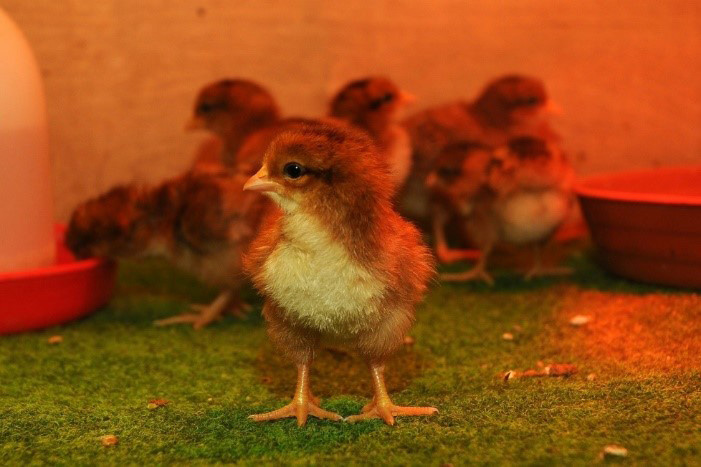
Brooder Safety
- Do not hang the lamp by the cord, a chain will provide strong and safe suspension
- Be sure that the lamp does not get close enough to catch the bedding on fire
- Protect the bulb from splashing water (water splashed on the hot bulb will shatter it); where possible use a ‘Hard Glass’ bulb
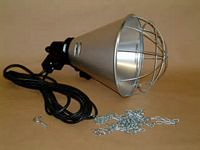
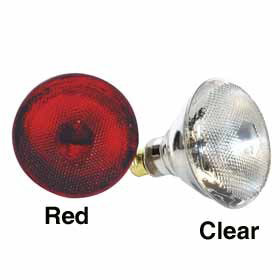
In the absence of a thermometer, monitoring chick behavior can help you determine if the temperature in the brooder is suitable for proper chick health. Chicks that are cold will huddle together under the heat lamp. Chicks that are too warm will move as far from the lamp as the brooder ring will allow. If the brooder area is drafty, the chicks will move to one side of the brooder in an attempt to escape the draft and still keep warm. If the temperature is just right the chicks will be evenly distributed with in the brooder area, softly chirping and pecking around.
"Newly hatched chicks cannot control their body temperature in the first few weeks of life. It is essential that they have a source of heat."
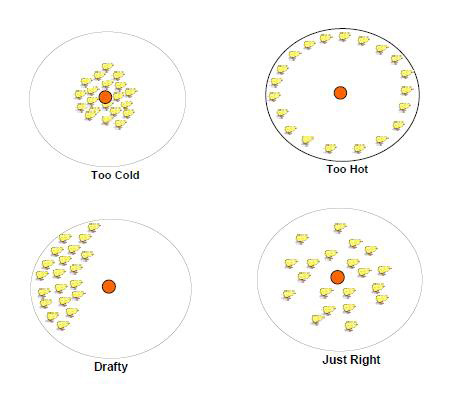
based on chick behavior.
Place some kind of bedding or litter on the floor to absorb moisture. A variety of materials can be used including wood shavings (most common and effective), ground corn cobs, peanut and rice hulls, and hay or stray that has been chopped into smaller pieces. Do not use shiny color printed newspaper, cardboard, or plastic, as the slippery surface may lead to leg damage.
Provide enough space at the feed and water to allow all chicks to eat or drink at the same time. Feed and water should be placed around the brooder like spokes of a wheel.
Make sure your new chicks drink water immediately, this can be done by dipping beaks in the water source to teach them where the water is. To make feed available place in a shallow dish or egg carton so that it is easy for them to find food. As they get bigger provide larger feeders. Chick waterers are available commercially in a variety of sizes, so consider the size of the water base when chicks are small. Clean feed and water should be constantly available to your chicks.
Getting your chicks off to a good start will keep them happy, healthy and productive!
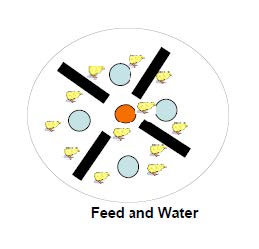
water in your brooder.
Download the Resource for the complete fact sheet and a printable version.
